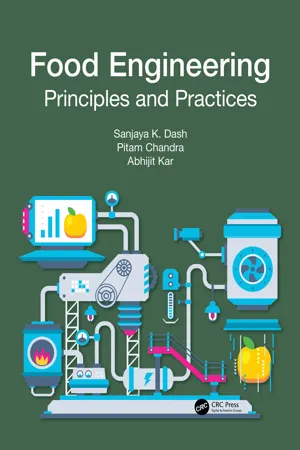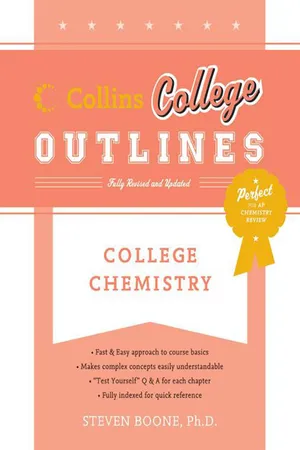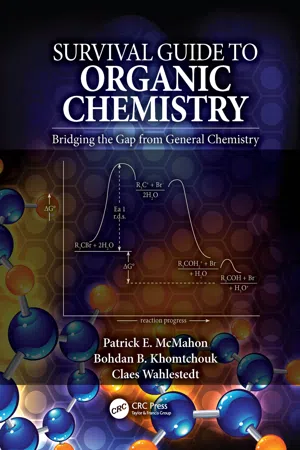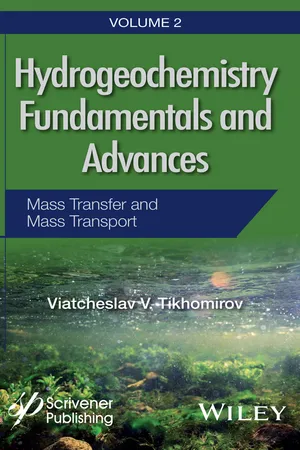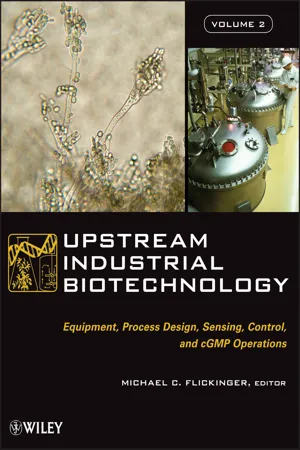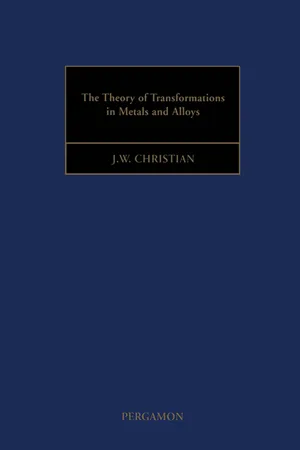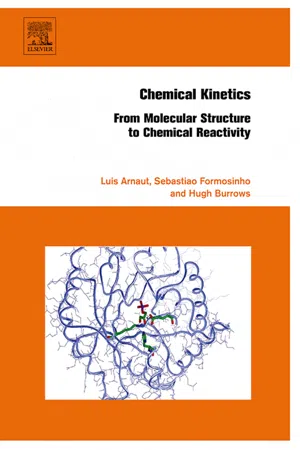Chemistry
Zero Order Reaction
A zero order reaction is a chemical reaction in which the rate of reaction is independent of the concentration of the reactant. This means that the rate of the reaction remains constant over time, regardless of changes in reactant concentration. In a zero order reaction, the rate law is typically expressed as rate = k, where k is the rate constant.
Written by Perlego with AI-assistance
Related key terms
Related key terms
1 of 4
Related key terms
1 of 3
9 Key excerpts on "Zero Order Reaction"
- eBook - ePub
Food Engineering
Principles and Practices
- Sanjaya K. Dash, Pitam Chandra, Abhijit Kar(Authors)
- 2023(Publication Date)
- CRC Press(Publisher)
In the rate equations, the rate constant is constant for a given reaction only if the concentration of the reactants is changed. However, as we will discuss later, k varies with change in temperature or in the presence of a catalyst.It is not possible to deduce the order of a reaction from the reaction’s chemical equation. The orders of reactions may be different from the actual number of molecules colliding (Stoichiometry molecularity). It is only in elementary reactions that the Stoichiometry molecularity and order of reaction are the same, that is, in one-step reactions.The order of a reaction need not necessarily be a whole number, it can also have zero and fractional values. In very simple forms the orders of reaction are 0, 1, or 2.4.1.1 Zeroth Order Reaction
If the reaction rate is constant for a particular component, then the superscript of the concentration in equation 4.4 will have a zero value, and hence it is a zeroth order reaction.rate = k = k [A]0 (4.6)The equation expresses that the reaction rate is independent of the reactant’s concentration. To represent the change in concentration (C) of a particular component with time (θ), the above equation can be written asdC/dθ = −k (4.7)Integrating within the time limits, 0 to θ (at time 0, the concentration is C0 and at time θ, the concentration is C),C0 − C = kθ (4.8)Zeroth order reactions are less common and are generally observed when the reactants saturate a material, such as a surface or a catalyst, used in the reactions. The chemical reaction 2HI(g) → H2(g) + I2(g) is an example of a zeroth order reaction. Similarly, when gaseous ammonia decomposes on a hot platinum surface at high pressure, the rate of reaction remains constant.2NH3(gas)→ N2(gas)+ 3H2(gas)Half-life of a chemical reaction is the time elapsed for the depletion of the reactant to fifty percent of its initial value. If C0 is the initial concentration of the reactant for a zeroth order reaction then C0 /2k is the half-life. If C is given in mol· l−1 and the time is given in s, the rate constant will have a unit of mol· l−1 · s−1 - No longer available |Learn more
- Steven Boone, Drew H. Wolfe(Authors)
- 2011(Publication Date)
- Collins Reference(Publisher)
Consider the zero-order reaction when A decomposes to products (A → products). The rate equation of a Zero Order Reaction has the following general form.rate = k [A]0Because [A]0 equals one, the rate equation becomes rate = k . Thus, in zero-order reactions, the rate of reaction is independent of the concentration of the reactant. The instantaneous rate of a zero-order reaction may be expressed as follows.This equation may be converted (using calculus) to the integrated rate law equation, a more useful equation with time and concentration variables.[A]t = −kt + [A]0This equation shows that a linear relationship exists between time and the concentration of A, where [A]t is the concentration of A at time = t , and [A]0 is the initial concentration of A, at time = 0. The slope of this line is −k and the y -intercept is [A]0 .First-Order Reactions, Concentration, and Time Relationship If reactant A undergoes a first-order decomposition to products (A → products), the instantaneous rate law equation, which is: may be integrated. The first-order integrated rate law equation follows.In this equation, In is the natural logarithm (loge ), [A]0 is the initial concentration of A, [A]t is the concentration of A at time t , and k is the rate constant with a reciprocal time unit such as -1 .Exercise 14.12The decomposition of acetone, CH3 COCH3 - eBook - ePub
Survival Guide to Organic Chemistry
Bridging the Gap from General Chemistry
- Patrick E. McMahon, Bohdan B. Khomtchouk, Claes Wahlestedt(Authors)
- 2016(Publication Date)
- CRC Press(Publisher)
Figure 1 .- Do not confuse rate with concentration . The concentration of “A ” changes continuously with time, but the rate of change of the concentration remains the same (constant slope). The number of molecules of “A ” consumed by reaction per unit time does not change as the concentration of “A ” decreases.
- A kinetic analysis which yields a straight line plot of reactant concentration ([reactant]) versus time, specifically characterizes that reactant as being zero order in the overall rate expression.
9.3.3 FIRST-ORDER REACTANTS
- A more common situation occurs when the rate of the reaction changes as a direct function of the concentration of a specific reactant. In this case, the reaction is termed “first order in component ‘A’.”r a t e( r )= k[ A ]1(equivalent to)r a t e = k[ A ]
- In addition to chemical reactions, this general behavior is widely seen in examples such as exponential growth of population or exponential growth of invested money.
- Exponential decrease (exponential decay) can also occur, as is the case for a chemical reaction where “A” is a reac-tant being consumed . The relationships can be summed up as: the more you have to start with, the faster the results (increase or decrease) multiply .
- To derive useful equations, consider a simple one-step reaction with “A ” as the only reactant: (An example would be a rearrangement of bonding pattern using all the same atoms; termed an isomerization reaction.)A → B
- Figure 2 depicts the change in [A] versus time . This is an exponential “decay” (decrease); the slope of the curve becomes continuously less negative as concentration of reactant “A
- eBook - ePub
- Pieter Walstra(Author)
- 2002(Publication Date)
- CRC Press(Publisher)
-1 , etc.For a zero-order reaction, the rate remains constant: see Table 4.1 . Approximately zero-order reactions occur, for instance, if small quantities of a substance, say one causing an off—flavor, are slowly formed from a very large reservoir of a parent component.For a first-order reaction of the type , we have(4.2a)where [A] stands for the molar concentration of A and k is the rate constant, which in this case is in s-1 ·k varies with temperature and pressure, but it is generally assumed to be constant otherwise, i.e., independent of concentration; this is often (nearly) true, but not always. Integrating the equation, and introducing the initial concentration of A, we obtain(4.2b)or(4.2c)*where τ is the relaxation time. If we plot the log of the concentration versus time, we thus obtain a straight line. The relations are illustrated in Figure 4.1 . If, for example, 10% of A is left after D s, this means that 1% is left after 2D s, 0.1% after 3D s, and so on; D, which equals 2.3/k, is called the decimal reduction time and is mostly used by microbiologists. The killing of microorganisms and the inactivation of enzymes at high temperature often follow first-order kinetics, at least approximately. Also bacterial growth in the so-called exponential phase follows first order kinetics, but now the sign in Eq. (4.2a ) is positive.The relaxation time is mostly used by physical chemists and is the time needed for a certain change to occur over (1- 1 /e - eBook - ePub
Reaction Kinetics
Homogeneous Gas Reactions
- Keith J. Laidler, Robert Robinson, H. M. N. H. Irving, L. A. K. Staveley(Authors)
- 2013(Publication Date)
- Pergamon(Publisher)
t .It is important to note that the rate of a chemical reaction may have a different numerical value according to the way it is defined and measured. Consider, for example, the reactionSince every time one molecule of nitrogen reacts two molecules of ammonia are formed it is evident that the rate of formation of ammonia, υNH 2 , is twice the rate of disappearance of nitrogen, υN 2 :(1)Similarly the rate of disappearance of hydrogen, υH2, is three times the rate of disappearance of nitrogen,(2)Order of Reaction
In some reactions the rates are proportional to the concentrations of reactants raised to some power; in such cases, and only in such cases, it is convenient to speak of the order of a reaction. Thus if a rate is directly proportional to a single concentration,(3)the reaction is said to be of the first order. An example of such a reaction is the decomposition of ethane in the gas phase, Under the usual experimental conditions the rate of appearance of ethylene, equal to the rate of disappearance of ethane, is proportional to the first power of the ethane concentration or pressure.The term second order is applied to two types of reactions: those in which the rate is proportional to the square of a single concentration,(4)and those in which it is proportional to the product of two concentrations of different reactants,(5)An example of the first type is the decomposition of gaseous hydrogen iodide, for which the rate from left to right is proportional to the square of the hydrogen iodide concentration. The rate of the reverse reaction, is proportional to the product of the concentrations of hydrogen and iodine, and the reaction is therefore also of the second order. It is, in fact, first order in hydrogen and first order in iodine. - Viatcheslav V. Tikhomirov(Author)
- 2016(Publication Date)
- Wiley-Scrivener(Publisher)
molecularity and is a positive integer: 1, 2 and very rarely 3. The probability of a collision between 4 and more particles simultaneously is disappearing small. An example of a monomolecular elementary reaction is dissociation:An example of bimolecular elementary reaction is association:As previously noted, Norwegians Guldberg and Waage in 1864 and 1867 showed that the rates of such reactions are proportionate to the product of concentrations of their reactants. This discovery formed the main postulate of the chemical kinetics: the rate of chemical reactions is proportionate to the product of reactants concentrations to the power of their stoichiometric coefficients. Because of this the equation, which ties up rate of reactions with concentrations (or partial pressures) of reactants, has the following format(1.121)And is called kinetic equation or reaction rate law. Here rv,j is rate of reactions normalized over volume, CM,ij is molar concentrations of reactants, kr,j is constant value characterizing the rate reactions at reactants concentration equal to 1, which is called reaction rate constant or intrinsic reaction rate, vij is stoichiometric coefficient of the component i usually called partial order of reaction. Sum of one reaction partial order determines order of the reaction overall or order of its rate law. Elementary reactions (acts) dominate, which are subject to the rate law of zero, first and second order. For instance, for an elementary direct reactionwe have where partial order of NO is equal to 2, and the order of the reaction overall – to 3.Zero-order reaction means no correlation between reaction rate and reactants concentration. With given reactions rate at constant temperature in unchangeable in time:(1.122)kr,j have dimension of reaction rate (velocity) (mole·m−3 ·s−1 ). The reactant content in such reactions decreases linearly according to equation(1.123)where CM,ji,0 and CM,ji,t are content of components i in the beginning and at the end of time interval Δt. The time of halving the reactant content is called half-life period.- eBook - ePub
- Michael C. Flickinger(Author)
- 2013(Publication Date)
- Wiley(Publisher)
If the kinetic order of inspected reactions is different, then we have to equalize the respective rate of expressions; for example, the second-order rate constant k (time) −1 (concentration) −1 should be multiplied by instant concentration of reactant s to be compared with the first-order rate constant having dimension (time) −1. The dimensions of the zero-, first-, and second-order rate constants are shown in Table 17.4. Table 17.4 Kinetic Order of Chemical Reactions 17.3.3 Reaction Dynamics If rate constant and so-called initial conditions [concentrations of reactants at zero-time (s 01, s 02, …)], are known, then it is possible to calculate the time course of reactions either in terms of dynamics of residual reactant concentration, s (t) or product accumulation, p (t). For this purpose, we have to integrate a differential equation under specified initial conditions (see results of integration in Table 17.4). The dynamics of s (t) is linear in the case of a zero-order reaction, exponential in the case of the first order and hyperbolic in the case of the second-order reaction. The difference between the last two dynamic curves can be made visible with a semilogarithmic plot of log (concentration) versus time; it should become linear for the first-order reaction and remain to be curvilinear for the reaction of higher order. 17.3.4 Reaction Half-Time The reaction half-time (t 0.5) is a very popular kinetic parameter. It is easily calculated from integral equations by putting s = s 0 /2 when t = t 0.5. A unique feature of the first-order reaction is the constancy of t 0.5 independently of the initial reactant concentration s 0. However, the half-time of other reactions does depend on s 0 ; it increases for zero-order reactions and decreases for the second-order reactions with increase in s 0 - John Christian(Author)
- 2002(Publication Date)
- Pergamon(Publisher)
If the whole reaction consists of one unit step, we might expect the molecularity to equal the order of the reaction. This is generally true, but there is one important exception which we shall mention below. When there are several atomic processes, there is usually one which is much slower than the others, and the overall reaction rate is then determined almost entirely by the rate applicable to this unit step. In this case, the overall order of the reaction will be equal to the molecularity of this rate determining step. In complex reactions there may be two or more slow steps, and the whole reaction does not then have a well-defined order, though each unit step still has a definite molecularity. The one exception to these simple rules is the monomolecular gas reaction discussed above. The kinetic theory of gases shows that this is first order at high pressures and second order at low pressures.The distinction between reaction order which refers to the overall change, and molecularity which refers to the mechanism should be remembered, but will not concern us further. In metallic transformations we shall encounter only first-order unimolecular reactions and second-order bimolecular reactions. In the equations of this chapter we shall use an undetermined number of concentration terms in the expressions for the reaction rate in order to facilitate comparison with standard chemical textbooks. The actual number of terms must be determined for the unit step in any process considered.A chemical reaction such as that represented by eqn. (12.1) does not usually proceed to completion, but is reversible. The assembly then tends to an equilibrium state in which the concentrations of products and reactants remain constant. This equilibrium is the result of a dynamic balance between the forward and reverse reactions, which continue on an atomic scale, but with equal velocities. There must then be a connection between the specific rate constants for the two reactions and the thermodynamic equilibrium constant which describes the macroscopic state of the assembly.The rates of the forward and back reactions may be written k f f f (c A , c B , …) and k b f b (c P , c Q , …), where the form of the functions f- eBook - ePub
Chemical Kinetics
From Molecular Structure to Chemical Reactivity
- Luis Arnaut, Hugh Burrows(Authors)
- 2006(Publication Date)
- Elsevier Science(Publisher)
obtain [ A ] − [ A ] 0 = [ B ] − [ B ] 0 [ A ] − [ B ] = [ A ] 0 − [ B ] 0 (4.17) (4.17) Using, separately, the first and third members, and the second and third members of eq. (4.16), we obtain the two equations [1] : d[A] [ A ] = − k 2 [ B ] d t d[B] [ B ] = − k 2 [ A ] d t (4.18) (4.18) and subtraction of these then yields d[A] [ A ] − d[B] [ B ] = k 2 ([ A ] − [ B ]) d t (4.19) (4.19) Using the mass balance eq. (4.17), we can write d[A] [ A ] − d[B] [ B ] = k 2 ([ A ] 0 − [ B ] 0) d t (4.20) (4.20) which can be integrated from time t = 0 to time t, to give ln ([ A ] [ A ] 0) − ln ([ B ] [ B ] 0) = k 2 t ([ B ] 0 − [ A ] 0) (4.21) (4.21) or,. rearranging 1 [ A ] 0 − [ B ] 0 − ln { [ B ] 0 [ A ] [ A ] 0 [ B ] } = k 2 t (4.22) (4.22) A plot of log ([B]/[A]) as a function of the time will have a slope of ([B] 0 — [A] 0) k 2 /2.3. For the case of second-order reactions in which the initial concentration can be expressed in terms of a single variable, [A] = [B] = [A] 0 – x = [B] 0 – x. When x = 0 for t = 0, the integration of eq. (4.16), after substitution for this variable, gives, x [ A ] 0 ([ A ] 0 − x) = k 2 t (4.23) (4.23) 4.1.3 Zero-order reactions Even though concentration of reactants has been given as one of the factors on which reaction rates depend, there are also cases of reactions that are independent of reactant concentration. In this case, the differential rate law is constant − d[A] d t = k 0 (4.24) (4.24) On integrating, we obtain [ A ] = [ A ] 0 − k 0 t (4.25) (4.25) Thus, a zero-order reaction gives a linear plot of change in concentration as a function of time, with slope equal to –k 0. The units of this rate constant are identical to those of the rate (e.g. litres per second)
Index pages curate the most relevant extracts from our library of academic textbooks. They’ve been created using an in-house natural language model (NLM), each adding context and meaning to key research topics.
Explore more topic indexes
Explore more topic indexes
1 of 6
Explore more topic indexes
1 of 4
